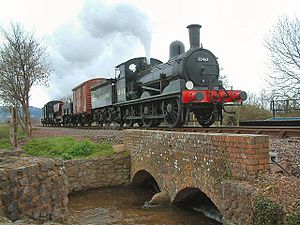GER Class Y14

No. 65462 with a demonstration freight train
|
|||||||||||||||||||||||||||||
|
|||||||||||||||||||||||||||||
|
|||||||||||||||||||||||||||||
|
|||||||||||||||||||||||||||||
|
|||||||||||||||||||||||||||||
| Type and origin | |
|---|---|
| Power type | Steam |
| Designer | T. W. Worsdell |
| Builder |
Stratford Works (270) Sharp, Stewart & Co. (19) |
| Build date | 1883-1913 |
| Total produced | 289 |
| Specifications | |
|---|---|
| Configuration | 0-6-0 |
| UIC class | C n2 |
| Gauge | 4 ft 8 1⁄2 in (1,435 mm) standard gauge |
| Driver dia. | 4 ft 11 in (1.499 m) |
| Length | 47 ft 3 in (14.40 m) |
| Loco weight | 37.1 long tons (37.7 t; 41.6 short tons) |
| Tender weight | 30.65 long tons (31.14 t; 34.33 short tons) |
| Fuel type | Coal |
| Fuel capacity | 5 long tons (5.1 t; 5.6 short tons) |
| Water cap | 2,640 imp gal (12,000 l; 3,170 US gal) |
| Boiler pressure | 160 psi (1,100 kPa) |
| Cylinders | Two, inside |
| Cylinder size | 17 1⁄2 in × 24 in (444 mm × 610 mm) |
| Performance figures | |
|---|---|
| Tractive effort | 16,940 lbf (75,400 N) |
| Career | |
|---|---|
| Operators | |
| Class |
|
| Power class | BR: 1P2F |
| Axle load class | LNER/BR: Route availability 1 |
| Disposition | One preserved, remainder scrapped |
The Great Eastern Railway (GER) Class Y14 is a class of 0-6-0 steam locomotive. The LNER classified them J15.
The Class Y14 was designed by T.W. Worsdell for both freight and passenger duties - a veritable 'maid of all work'. Introduced in July 1883, they were so successful that all the succeeding chief superintendents continued to build new batches down to 1913 with little design change, the final total being 289. During World War I, 43 of the engines served in France and Belgium.
On 10–11 December 1891, the Great Eastern Railway's Stratford Works built one of these locomotives and had it in steam with a coat of grey primer in 9 hours 47 minutes; this remains a world record. The locomotive then went off to run 36,000 miles (58,000 km) on Peterborough to London coal trains before coming back to the works for the final coat of paint. It lasted 40 years and ran a total of 1,127,750 miles (1,814,940 km).
Because of their light weight the locomotives were given the Route Availability (RA) number 1, indicating that they could work over nearly all routes.
As built all the locomotives had a stovepipe chimney; this was replaced in LNER days by a cast chimney with a small lip. The original Worsdell and early Holden series had three-ring boilers with the steam dome placed in the middle. Also the Worsdell boilers had a flat grate, however from 1890 Holden developed a boiler with a sloping grate and a two-ring telescopic barrel with the dome located well forward. The advantage of the dome position was a short 5½ inch steam pipe which limited pressure drop between the boiler and the cylinders. This boiler was adopted as standard and persisted on all Great Eastern Locomotives down to 1898; from then on it was perpetuated on the smaller locomotives as long as these remained essentially in their original configuration - which could be down to the 1960s.
...
Wikipedia
